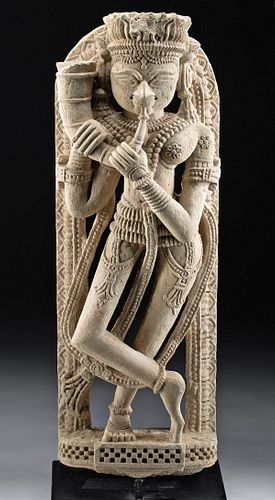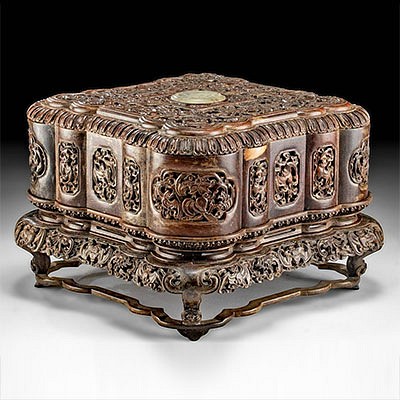Indian Gujarat Stone Celestial Musician Playing a Horn
Lot 38
About Seller
Artemis Gallery
686 S Taylor Ave, Ste 106
Louisville, CO 80027
United States
Selling antiquities, ancient and ethnographic art online since 1993, Artemis Gallery specializes in Classical Antiquities (Egyptian, Greek, Roman, Near Eastern), Asian, Pre-Columbian, African / Tribal / Oceanographic art. Our extensive inventory includes pottery, stone, metal, wood, glass and textil...Read more
Categories
Estimate:
$8,000 - $12,000
Absentee vs Live bid
Two ways to bid:
- Leave a max absentee bid and the platform will bid on your behalf up to your maximum bid during the live auction.
- Bid live during the auction and your bids will be submitted real-time to the auctioneer.
Bid Increments
| Price | Bid Increment |
|---|---|
| $0 | $25 |
| $300 | $50 |
| $1,000 | $100 |
| $2,000 | $250 |
| $5,000 | $500 |
| $10,000 | $1,000 |
| $20,000 | $2,500 |
| $50,000 | $5,000 |
| $100,000 | $10,000 |
| $200,000 | $20,000 |
About Auction
By Artemis Gallery
Apr 8, 2021
Set Reminder
2021-04-08 10:00:00
2021-04-08 10:00:00
America/New_York
Bidsquare
Bidsquare : Fine Antiquities | Asian | Ethnographic Art
https://www.bidsquare.com/auctions/artemis-gallery/fine-antiquities-asian-ethnographic-art-6770
Features classical antiquities, ancient and ethnographic art from cultures encompassing the globe. Egyptian, Greek, Roman, Etruscan, Near Eastern, Asian, Pre-Columbian, Native American, African / Tribal, Oceanic, Spanish Colonial, Russian, Fine Art, so much more! All legally acquired, legal to sell. Artemis Gallery info@artemisgallery.com
Features classical antiquities, ancient and ethnographic art from cultures encompassing the globe. Egyptian, Greek, Roman, Etruscan, Near Eastern, Asian, Pre-Columbian, Native American, African / Tribal, Oceanic, Spanish Colonial, Russian, Fine Art, so much more! All legally acquired, legal to sell. Artemis Gallery info@artemisgallery.com
- Lot Description
South Asia, India, Gujarat, ca. 10th to 13th century CE. A finely carved stone statue of an elegant celestial musician, lavishly bedecked with an elaborate crown, several beaded strands adorning the neck and torso, armbands, bracelets, earrings, and a bejeweled belt, while playing a horn and standing with the right leg crossed over the left leg in a dance-like swaying pose. The attention to detail is impressive. Notice the petaled flowers adorning her left breast, arm, and earring; the exquisite stone arch that the figure leans against which is intricately decorated with a beaded and stylized leaf border; as well as the front face of the base which is adorned by a meticulously rendered checkerboard motif with squares in alternating positive and negative relief. Quite a remarkable ancient Gujarat statue of a celestial musician! Size: 6.5" L x 10.875" W x 31.375" H (16.5 cm x 27.6 cm x 79.7 cm); 33.625" H (85.4 cm) on included custom stand.
The hornpipe may be a reference an Indian bull horn which is a traditional wind instrument used during festivals or sacred religious ceremonies known as pujas. Also known as a Pepa, Ranasringa, Kombu, and Sringa, this instrument has been used since ancient times and plays an important role in the Bihu festival, the Assamese new year, and the rice harvest festival. According to Dharma, while the cow is honored as a mother who provides nourishing milk, the bull is also respected for its role in agriculture, used for ploughing, transporting, as well as raising crops.
Provenance: private Hawaii, USA collection; ex-private Micklautz collection, Hawaii, USA, collected from 1940-1998
All items legal to buy/sell under U.S. Statute covering cultural patrimony Code 2600, CHAPTER 14, and are guaranteed to be as described or your money back.
A Certificate of Authenticity will accompany all winning bids.
We ship worldwide and handle all shipping in-house for your convenience.
#163122Losses to headdress/coiffure/top of head, top of horn, and base as shown. A small section of arch has been reattached at the lower right. Perforation through center of base, perhaps for previous attachment. Expected surface wear with abrasions and chips/nicks to high-pointed areas of figure, horn, and surrounding arch and base. Nice remains of white stucco suggests this statue may have been embellished with pigments at one time.Condition
- Shipping Info
-
All shipping is handled in-house for your convenience. Your invoice from Artemis Gallery will include shipping calculation instructions. If in doubt, please inquire BEFORE bidding for estimated shipping costs for individual items.
-
- Buyer's Premium



 EUR
EUR CAD
CAD AUD
AUD GBP
GBP MXN
MXN HKD
HKD CNY
CNY MYR
MYR SEK
SEK SGD
SGD CHF
CHF THB
THB













